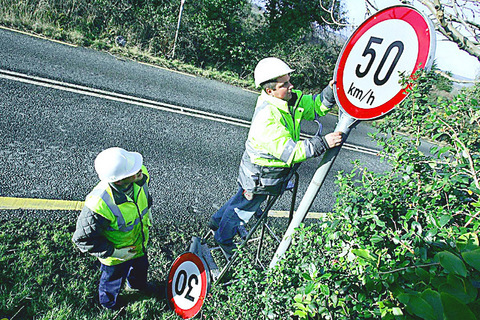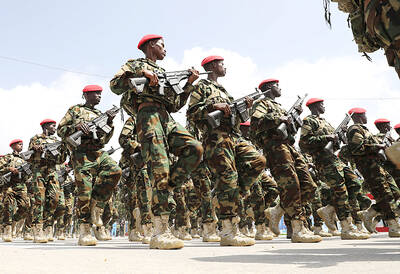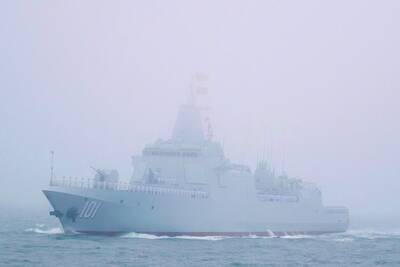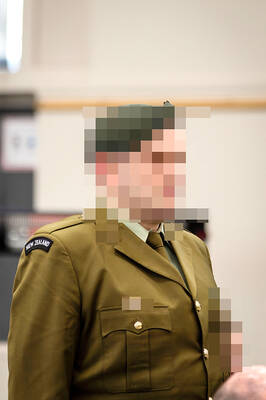Chugging tractors and herds of sheep will still occasionally block narrow country lanes, but another quirky challenge of navigating rural Ireland disappeared on Tuesday night as the country switched its speed limits from miles per hour to kilometers per hour.
For the last week, amused commuters along major roads watched as workers replaced 35,000 old signs and hammered in 23,000 new ones. The change ended a decades-old discrepancy between speed limits, which have been posted in miles per hour, and distances, which are usually -- but far from always -- posted in kilometers.

PHOTO: EPA
EU rules require that all distance signs be converted to kilometers by the end of the year, and Ireland is finally putting into place many of the standards it pledged to adopt when it joined the bloc in 1973.
As part of Ireland's embracing of the metric system, the Parliament ordered the change for speed limits. The government spent US$15 million on the changeover, of which US$3.3 million went to broadcast advertising, ubiquitous billboards and fliers delivered to every household in the country, so few people expect much difficulty adjusting.
Ireland is familiar with broad changes in national systems. Its original currency, the punt, was converted from Britain's base-12 shilling system to decimals in 1971, and politicians were surprised at how seamlessly the country switched to the euro three years ago.
The EU requires weights and volumes of saleable goods to be displayed in metric units, although one exception in the British Isles -- a pint of beer -- is unlikely to be sold in 568-milliliter glasses anytime soon.
For drivers in Ireland, "the appearance of more signs on our roads has increased their awareness of speed limits generally," Transportation Minister Martin Cullen said. "If motorists are more aware of their driving environment, our roads will be safer places."
Cullen also lowered the speed limit on local roads, which make up 90 percent of the road network, from 60 to 48 miles per hour, or 100km to 80km, while the top limit on highways rose to 120km, or about 75 miles, per hour.
"I knew it was going to happen eventually," said Tom Carroll, a 69-year-old taxi driver, who suggested that the government harmonize with the European standard on a slightly bigger issue.
"I'd prefer if we switched to driving on the right-hand side of the road," he said.

ELECTION DISTRACTION? When attention shifted away from the fight against the militants to politics, losses and setbacks in the battlefield increased, an analyst said Recent clashes in Somalia’s semi-autonomous Jubaland region are alarming experts, exposing cracks in the country’s federal system and creating an opening for militant group al-Shabaab to gain ground. Following years of conflict, Somalia is a loose federation of five semi-autonomous member states — Puntland, Jubaland, Galmudug, Hirshabelle and South West — that maintain often fractious relations with the central government in the capital, Mogadishu. However, ahead of elections next year, Somalia has sought to assert control over its member states, which security analysts said has created gaps for al-Shabaab infiltration. Last week, two Somalian soldiers were killed in clashes between pro-government forces and

Ten cheetah cubs held in captivity since birth and destined for international wildlife trade markets have been rescued in Somaliland, a breakaway region of Somalia. They were all in stable condition despite all of them having been undernourished and limping due to being tied in captivity for months, said Laurie Marker, founder of the Cheetah Conservation Fund, which is caring for the cubs. One eight-month-old cub was unable to walk after been tied up for six months, while a five-month-old was “very malnourished [a bag of bones], with sores all over her body and full of botfly maggots which are under the

BRUSHED OFF: An ambassador to Australia previously said that Beijing does not see a reason to apologize for its naval exercises and military maneuvers in international areas China set off alarm bells in New Zealand when it dispatched powerful warships on unprecedented missions in the South Pacific without explanation, military documents showed. Beijing has spent years expanding its reach in the southern Pacific Ocean, courting island nations with new hospitals, freshly paved roads and generous offers of climate aid. However, these diplomatic efforts have increasingly been accompanied by more overt displays of military power. Three Chinese warships sailed the Tasman Sea between Australia and New Zealand in February, the first time such a task group had been sighted in those waters. “We have never seen vessels with this capability

‘NO INTEGRITY’: The chief judge expressed concern over how the sentence would be perceived given that military detention is believed to be easier than civilian prison A military court yesterday sentenced a New Zealand soldier to two years’ detention for attempting to spy for a foreign power. The soldier, whose name has been suppressed, admitted to attempted espionage, accessing a computer system for a dishonest purpose and knowingly possessing an objectionable publication. He was ordered into military detention at Burnham Military Camp near Christchurch and would be dismissed from the New Zealand Defence Force at the end of his sentence. His admission and its acceptance by the court marked the first spying conviction in New Zealand’s history. The soldier would be paid at half his previous rate until his dismissal